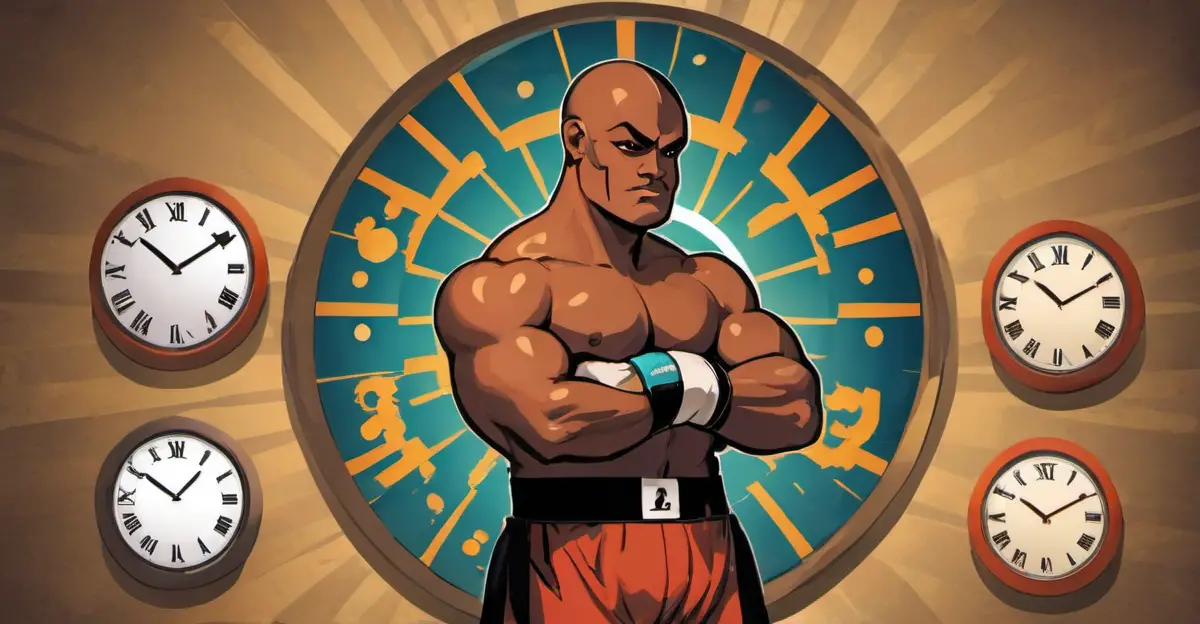Did you know that a standard boxing match consists of 12 three-minute rounds? But have you ever wondered why these specific time intervals were chosen?
A boxing match is a high-intensity, physically demanding activity that requires precision timing. From the bell to the final knock-out blow, every second counts. However, beyond the excitement and drama of a live fight lies a complex system governed by strict rules and regulations.
In this article, we’ll delve into the world of professional boxing and explore the essential facts you need to know about round times. Whether you’re an avid fan or a seasoned fighter, understanding the intricacies of a boxing match is crucial for fully appreciating the sport.
The History Behind Boxing Round Times
- The earliest recorded boxing match dates back to ancient Greece in 688 BC.
- In the late 19th century, boxing underwent significant rule changes to ensure fairness and safety for all participants.

Minutes-in-a-Boxing-Round: Understanding the Crucial Time Frame
===========================================================
A Boxing Match in Minutes
A boxing match consists of rounds, each lasting a specific amount of time. Knowing how many minutes are in a boxing round is crucial for both participants and spectators. Imagine being at the edge of your seat, cheering on your favorite fighter as they take on their opponent. The tension builds with each passing minute, and the crowd’s energy grows exponentially.
Duration of a Typical Professional Boxing Round
In professional boxing, a standard round lasts 3 minutes, with a 1-minute rest period between rounds. This format allows fighters to recover and prepare for the next round. The bell rings, signaling the start of each round, and the referee takes their position in the center of the ring. The fighters face off, ready to give it their all as they exchange blows and test each other’s limits.
Factors that May Affect Round Time
While a standard round typically lasts 3 minutes, some factors like weight classes or special events might result in variations of this time frame. For instance, in junior boxing matches, the rounds may be shorter to accommodate the younger fighters’ energy levels and endurance. Understanding these nuances is essential for both participants and spectators to fully appreciate the sport.
The Psychology of a Boxing Round
A boxing round is not just about physical endurance; it’s also a mental challenge. Fighters must focus on their strategy, anticipate their opponent’s moves, and stay in top shape to outlast them. As each minute ticks away, the pressure builds, and the fighters’ tactics become increasingly crucial. Will they conserve energy for a late-round surge or go all-out from the start? The suspense is palpable as the crowd waits with bated breath for the outcome.
What’s Next?
The next round is just minutes away, and the intensity will only grow. Stay tuned for more updates on the world of boxing and get ready to be on the edge of your seat once again!
How Many Minutes Are in a Boxing Round: Unlocking the Secret to Appreciating This Physically Demanding Sport
As we delve into the world of boxing, it’s essential to understand its intricacies. One fundamental aspect that sets boxing apart from other combat sports is its unique round structure. Knowing how many minutes are in a boxing round can greatly enhance your appreciation for this physically demanding sport.
The Structure of a Boxing Round
A standard boxing match consists of 12 three-minute rounds, with a one-minute rest period between each round. This means that the total duration of a typical professional boxing match is approximately 36 minutes. However, it’s crucial to note that some amateur and exhibition matches may have different time frames.

The Importance of Understanding Round Structure
Understanding how many minutes are in a boxing round can significantly impact your experience as a spectator or participant. For instance, if you’re watching a live match, knowing when the next round will start can help you better anticipate the fighters’ strategies and adjust your expectations accordingly. Similarly, if you’re participating in a match yourself, being aware of the time constraints can influence your pacing and decision-making during the competition.
The Impact on Strategy and Skill
The structure of boxing rounds also has a direct impact on the skill and strategy involved in this sport. Fighters must carefully manage their energy levels throughout each round, as they have limited time to execute their game plans. This means that even slight missteps can have significant consequences, making every minute count.
The Role of Timing in Boxing
Timing plays a critical role in boxing, particularly when it comes to landing precise strikes and dodging opponents’ attacks. By grasping the structure and duration of rounds, spectators can better appreciate the skill involved in timing their punches and movements. This appreciation extends beyond mere entertainment value, as understanding timing can also inform your own training and performance.
Conclusion
To effectively engage with boxing, understanding how many minutes are in a boxing round is essential. By grasping this fundamental aspect of the sport, spectators can better appreciate the skill and strategy involved in this physically demanding activity. As you continue to explore the world of boxing, keep in mind that each minute counts – for both fighters and fans alike.
As you navigate the world of boxing, it’s essential to recognize the significance of timing and strategy in this sport. By acknowledging the importance of understanding how many minutes are in a boxing round, you can enhance your appreciation for this physically demanding activity. Whether you’re watching a live match or participating in one yourself, being aware of the time constraints can greatly impact your experience.
For those interested in learning more about boxing or participating in it themselves, exploring resources like official rulebooks and training facilities would be a good starting point. By investing time and effort into understanding this complex sport, you can unlock new levels of appreciation and enjoyment.

